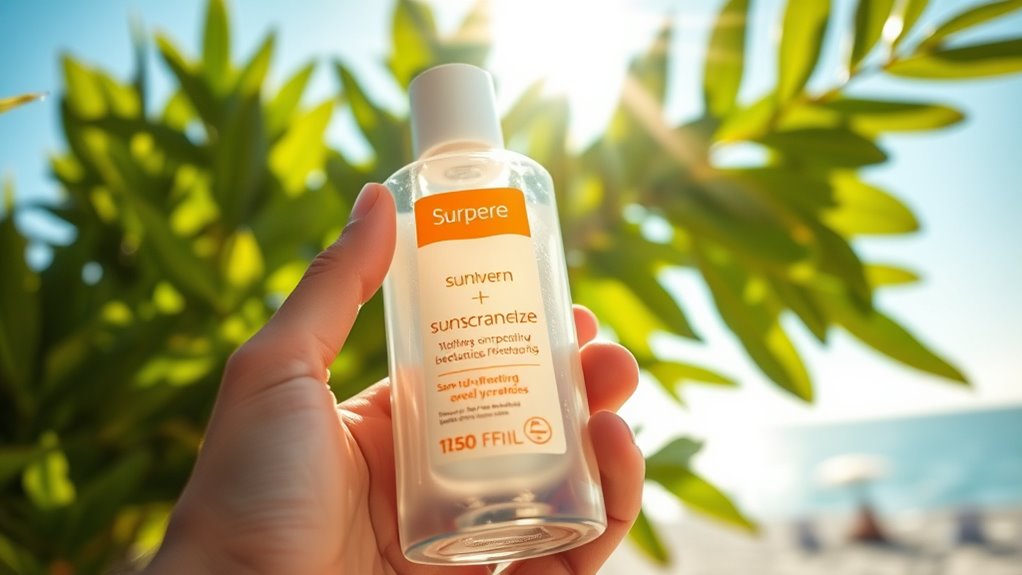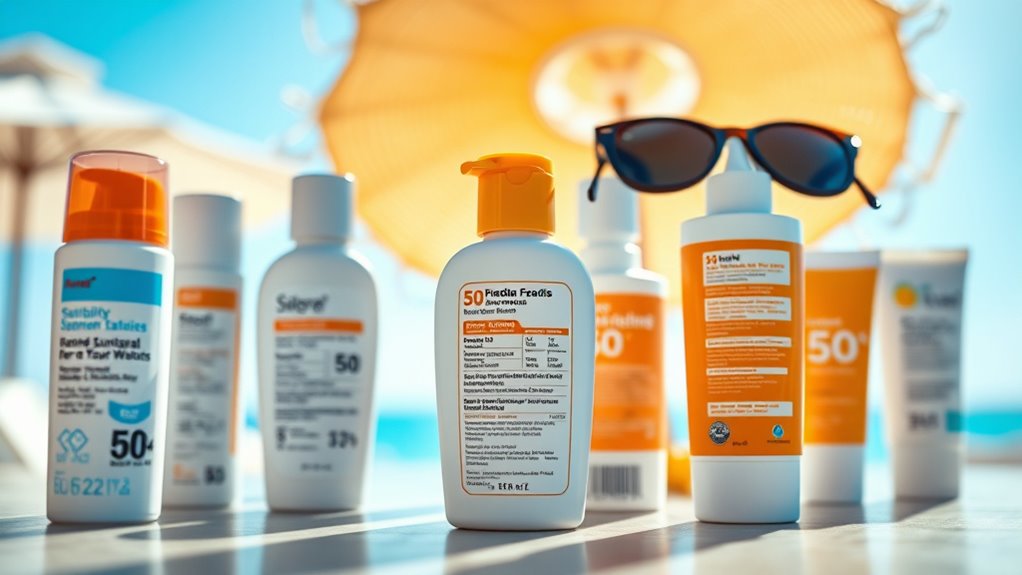The FDA has recently updated sunscreen regulations to boost safety, transparency, and effectiveness. You’ll see clearer ingredient labels, including all active and inactive ingredients, along with proper claims about SPF and water resistance. They’re also scrutinizing certain ingredients more closely to guarantee their safety, and new ingredients may get approval after thorough review. These changes aim to protect you better and support innovative formulations. Keep exploring to understand how these updates could impact your choices.
Key Takeaways
- The FDA is enhancing safety evaluations for sunscreen ingredients, especially new or less common ones.
- Ingredient labeling requirements now demand greater transparency and accuracy for both active and inactive components.
- New regulations aim to improve product efficacy, including clearer SPF, broad-spectrum protection, and water resistance claims.
- The FDA is reviewing and possibly approving innovative ingredients to support safer, more effective formulations.
- Overall, these updates strengthen consumer safety, transparency, and confidence in sunscreen products.

Have you ever wondered how sunscreen products are regulated to guarantee your safety? The answer lies in strict oversight by the FDA, which ensures that sunscreens meet specific standards before they reach your hands. The FDA compliance process is designed to protect consumers by making sure that ingredients used in sunscreens are safe and effective. This involves rigorous testing, review, and monitoring of products, so you can trust the labels on the bottles you buy. One key aspect of this regulation is ingredient labeling, which must clearly list all active and inactive ingredients. Accurate labeling helps you make informed choices, especially if you have allergies or sensitivities. The FDA requires that labels include details about the SPF, broad-spectrum protection, water resistance, and proper application instructions, so you’re equipped with the necessary information to use sunscreen correctly.
In recent updates, the FDA has emphasized the importance of transparent ingredient labeling, especially for ingredients that are new or less common. They’re now requiring manufacturers to provide more safety data for certain active ingredients to ensure they’re safe for broad use. This means some ingredients previously considered acceptable might face additional scrutiny, and new ingredients could be approved after thorough review. Additionally, the FDA is encouraging the development of innovative formulations, such as those incorporating Unique and Wicked Planters to enhance product appeal. This means some ingredients previously considered acceptable might face additional scrutiny, and new ingredients could be approved after thorough review. As a consumer, you benefit from this increased transparency because it helps you avoid products with potentially harmful or less effective ingredients. The FDA compliance process also involves monitoring ongoing safety and efficacy, so if any concerns arise about specific ingredients or formulations, the FDA can take swift action, including updating labeling requirements or removing products from the market.
Understanding these updates can seem complicated, but the core idea is that the FDA is working to make sunscreens safer and more transparent for you. The focus on ingredient labeling has become more stringent, ensuring that what’s on the label truly reflects what’s in the product. This helps you identify the active ingredients responsible for protection against UV rays and assess whether a product is suitable for your skin type or specific needs. By tightening regulations and emphasizing clear communication through ingredient labeling, the FDA aims to improve your overall safety while using sunscreen. Rest assured, these changes are designed with your health in mind, giving you confidence that the sunscreen you choose has been thoroughly evaluated and meets modern safety standards.
Frequently Asked Questions
How Will New Regulations Affect Sunscreen Pricing?
You might notice changes in sunscreen pricing due to new regulations focusing on pricing transparency and consumer affordability. Manufacturers could adjust prices to reflect the costs of compliance, potentially making some products more expensive. However, increased transparency might also lead to more competitive pricing, benefiting you as a consumer. While some prices may rise, the overall goal is to guarantee you can access safe, effective sunscreens without unexpected costs.
Are Mineral Sunscreens Impacted Differently Than Chemical Ones?
Did you know that mineral sunscreens make up about 20% of the US market? With new FDA rules, mineral sunscreens, which use physical blockers like zinc oxide and titanium dioxide, may face different regulations than chemical formulations. These changes could impact ingredient limits, labeling, and testing standards, possibly affecting your choices. So, you might find mineral sunscreens are impacted differently, influencing how you select products for effective sun protection.
Will Existing Sunscreen Products Remain Available After Regulation Updates?
You might wonder if your current sunscreens will stay on shelves after the new regulations. Generally, existing products that meet safety standards will remain available, but some formulations may change to comply with updated rules. This shift aims to enhance product safety and boost consumer awareness. Stay informed about label updates and ingredient changes to guarantee you’re choosing effective, compliant sunscreens that protect your skin well.
How Do Regulations Address Sunscreen Labeling Accuracy?
Your concern about UV protection and label accuracy is essential, as false labels could lead to serious skin damage. The new regulations require sunscreen companies to provide more precise and truthful labeling, ensuring that product claims on SPF and UV protection are reliable. This crackdown is like a shield, protecting consumers from misleading information. You can now trust that the labels on your sunscreen truly reflect its effectiveness, giving you confidence in your sun safety.
What Are the Penalties for Non-Compliance With New Regulations?
You should be aware that non-compliance with the new sunscreen regulations can lead to serious legal consequences. The FDA enforces strict penalties, including manufacturing fines, if you fail to meet the labeling accuracy and safety standards. These penalties aim to guarantee consumer safety and product integrity. Staying compliant helps you avoid costly fines and legal actions, so it’s essential to follow the updated guidelines closely.
Conclusion
So, with these new FDA rules, it looks like you’ll finally get the sunscreen clarity you’ve been dreaming of—no more confusing labels or false promises. Now, you can confidently slap on that SPF and pretend you’re a sun-safe superhero, all while waiting for the next big skincare scandal. Remember, sunscreen’s your best friend—unless, of course, you prefer risking a fiery lobster look. Stay protected, stay informed, and keep those UV rays at bay!









